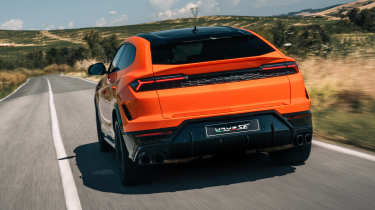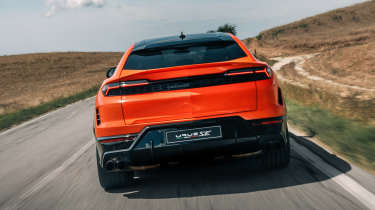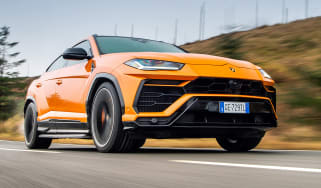Lamborghini Urus SE 2024 review – Sant'Agata's super SUV goes hybrid
Lamborghini’s answer to the Aston Martin DBX707 gets a major mid-life overhaul for 2024, going hybrid-only in the process. Has it become easier to like in the process?
The Lamborghini Urus is not the kind of performance car evo typically seeks, but there’s no denying its incredible success. A new breed of loyal owners have helped Sant'Agata replicate the ‘Cayenne effect’, exponentially raising sales and profits while carving out a following of its own. Six years since its launch, the Aston Martin DBX707-rival has received its most significant overhaul yet with the Urus SE.
This new model presents a new chapter for the Urus, a mid-life facelift that hybridises the whole range – indeed the whole Lamborghini range, once the Temerario ousts the Huracán from production – and is the core upon which a future Performante replacement will be based. And of course, it’s already sold out until 2026.
> Aston Martin DBX707 2024 review – still a step ahead of the pack?
Its combination of 4-litre twin-turbocharged V8, rear e-motor and 25.9kWh battery is familiar from other heavy-hitting VW Group cars, chiefly the Cayenne Turbo and new Bentley Continental GT. Chief technical officer Rouven Mohr insists Lambo never considered a downsized hybrid and that a chunky eight-cylinder heart is essential to the Urus experience. Different engine mounts to Bentley and Porsche are designed to preserve a bit of NVH to boost involvement. ‘We are not looking to eliminate every piece of feedback from the car,’ says Mohr. ‘It must retain an emotional connection.’
More reviews
Outputs are all slightly up on its cousins, a 612bhp tune of V8 pairing with a 189bhp motor for a 3.4sec sprint to 62mph. The added weight of the hybrid powertrain is notable, mind, tipping the Urus past the 2.5-tonne mark for the first time, albeit by 5kg. Lamborghini has seized an opportunity to overhaul the Urus’ dynamic character, the e-motor running through the eight-speed gearbox to have its power distributed via a central differential and rear e-LSD; the full combined totals of 789bhp and 700lb ft are spread variably fore and aft and then controlled laterally on the back axle. The car is always 4WD in regular use, though more extreme inputs can send every mite of power to the rear. ‘Hardware is still important, it’s the enabler to what you can now achieve with software,’ insists Mohr. ‘Companies that forget its importance will suffer.’
There are 11 combinations of drive mode, but you’ll need to finetune your Ego individual mode to feel like you have true autonomy. The left ‘tamburo’ trigger sequentially cycles through three tarmac and three off-road modes – a pain if you want to quickly nip from Sport back to Strada – while the right trigger instigates an EV mode which blanks out all other options in the process. Form has walloped function here, and perhaps my consternation at these controls proves I’m not quite the target audience. I still enjoy the chintzy red flap over the starter button, though, a mainstay since the launch of the Aventador.
The experience when you prod it to life is a little different here, however, the car defaulting to EV mode and the animation of its digital dials the main signifier you’re ready to go. While the facelift is a successful one, nicely smoothing out some aggression and calling to mind the gen2 Gallardo in its rear styling, this remains a brutal slice of car. Thus slinking around in near silence does wonders to ease your self-consciousness. Not that I imagine its most ardent buyers will be particularly concerned.
Notch the car into Strada mode and it’ll work more often as a hybrid, keener to involve the engine though at a refined and classy level. It will likely become your default for longer journeys; while the SE can hit 84mph in EV mode, it feels wasteful to cruise at such speeds without the V8. It’s the next tamburo flick, into Sport, that really sparks the engineers’ claims into life.
Whereas track-focused Corsa goes for neutrality, Sport is designed for fun. A spring immediately enters the car’s step and it doesn’t take much provocation for its rear axle to play a lead role out of roundabouts and tighter corners. Nothing too antisocial, just a giddy, up on its toes sensation that – given the space to play – will goad you on to drive yet harder to unlock more of its dynamism. Four-wheel steering and 48v anti-roll bars do their bit to chip away at the sensation of mass and its c300kg climb over the old Urus S does metaphorically shrink, at least a little.
The 4WD system is reactive to your inputs and predictive of your desires, but you’ll need very aggressive inputs to uncork its full drift capabilities. Learning the mindset of its software can yield cartoonish results, but the SE is naturally a lot of car to get moving on dry, warm tarmac. Perhaps that’s why Lamborghini took us to Nardo proving ground and its boisterous Strada Bianca gravel course, where the Urus slides with aplomb and its agility can be easily exploited even on its stock P Zeros. It’s where Mohr’s team honed the Huracán Sterrato. What a day at work that must have been…
The regen braking is adjustable to the driving mode, temperatures and battery charge level – but all via the car’s own brain rather than the driver’s fingers. In truth it all slips away into the background. Much like the Ferrari 296 GTB, it feels like the inevitable march to electrification has been woven into the car’s character as much as possible rather than reluctantly lumped on top. ‘You could do a purer internal combustion version but you’d lose a lot of the benefits,’ says Mohr when inevitably pushed on its chunky kerb weight. ‘Our new 4WD concept transforms the Urus. Put this car on Trofeo Rs and it’d be quicker than the old Performante.’
Mind, its battery only charges at 7kW (a dieting measure, apparently) and the engineers are keen to point out its ability to recharge at up to 80 per cent on the move, something they reckon lots of customers will exploit as low-emission cities become more prevalent. Fully topped up, the WLTP claims are 135.8mpg and 51g/km of CO2, while a discharged battery sees official fuel economy tumble to 21.9mpg. So the reality will fall somewhere in between, though surely much closer to the latter number than the former.
On the stonking 23-inch alloys of this test car, the ride is never less than busy over urban surfaces, though it gains a more confident stride with speed. Pirelli has developed a bespoke P Zero compound across the range but says its character shifts in an upward sliding scale from comfort to commitment, and I suspect the softer focus of the 21s or 22s will be more welcome if this is an everyday proposition – as the Urus typically is for many of those loyal customers.
I doubt they’ll be able to resist another upgrade and they’ll find a heck of a lot to like here. The Urus SE represents the most tangible and worthy progression yet in the car’s six-year life. As for the rest of us? evo’s frequent criticism of the Urus has been its lack of subtlety, but the extra sophistication in its styling and nuance to its handling do make the SE the most agreeable version yet. Plug-in power has usefully broadened its repertoire.
Its already formidable weight and price just happen to swell in the process, while its 37 miles of electric range and honourable on-paper emissions don’t quite provide the sort of green cred you’ll shout about while parking it up. It’s a more efficient Lamborghini, but it’s not the messiah. ‘A Lamborghini is one of the most sustainable products as it will never be thrown away,’ says design chief Mitja Borkert. Well, at least not until the next upgrade arrives…
Price and rivals
Just like most of its rivals, the Lamborghini Urus SE is sold out for a good couple of years, but if you can get your hands on one you’ll pay from £208,000. This figure makes the new Urus significantly less expensive than the £313,220 Ferrari Purosangue, but its pure-combustion V12 powertrain will always have a draw that nothing else can match – if you’re looking for outright numbers though, the 715bhp Ferrari still can’t quite match the new Urus.
Step from Italy to the United Kingdom and you’ll find that the new Urus is a near-exact match for the Aston Martin DBX707 with its £205,000 price tag. Like the Ferrari, this too goes without hybrid assistance, but its pure-combustion V8 powertrain only manages a 697bhp output, putting it quite some way behind the Lamborghini on paper.
The likes of the Range Rover Sport SV and Mercedes-AMG G63 will save you some cash at £171,460 and £184,595 respectively, but Porsche’s Cayenne Coupe Turbo E-Hybrid is the driver’s choice of the bunch, and costs from £144,500.
Lamborghini Urus SE specs
| Engine | V8, 3996cc, turbocharged, plus single e-motor |
| Power | 789bhp |
| Torque | 700lb ft |
| Weight | 2505kg |
| Tyres | Pirelli P Zero (bespoke compound, 285/35 23 front, 325/30 23 as tested) |
| Power-to-weight | 320bhp/ton |
| 0-62mph | 3.4sec |
| Top speed | 194mph |
| Price | £208,000 |








